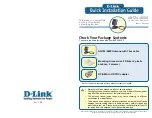
2
Introduction
The DX Engineering rotatable
DXE-RF-PRO-1B
Active Magnetic Loop Antenna is designed for
reception of signals over the range of 100 kHz to 30 MHz. The RF-PRO-1B
®
can be mounted to a
pole, mast or any flat surface. The included very high dynamic-range low-noise preamplifier is
designed for minimum intermodulation distortion in the presence of very high-level signals that
would normally overload most preamplifiers. This rotatable loop antenna is
receive ONLY.
Features
Same technology and quality as Pixel Technologies and InLogis loop antennas
Unique Loop architecture provides enhanced
performance
Magnetic loop that rejects near field electrical noise
Up to 30 dB rejection of locally radiated noise
compared to whip antennas
Figure eight directivity and deep nulls to further
reduce interference from local or distant signals
Very low IMD, 27 dB Low-Noise Clifton
Laboratories Norton Preamp insures good
performance in both strong and weak signal
environments
Useable coverage range: 100 kHz to 30 MHz
Rejects power line noise
Rugged construction, easily mounts to a pole or flat
vertical surface, 3/4 inch dia. aluminum loop,
supplied with preamplifier, power inserter and DC
power supply
No manual tuning necessary
No Home Owners Association problems; low
profile, easy to camouflage and works at a few feet
above ground level
Modular design for easy installation and maintenance
Internal transmit / receive relay disconnects the antenna / preamplifier from receiver when
transmitting
Antenna Design
The RF-PRO-1B
®
Loop Antenna consists of a rigid 3/4 inch diameter light-weight aluminum loop
and a balanced broadband preamplifier that is housed in a separate enclosure mounted close to the
antenna on its mast bracket. A 20 volt DC regulated power inserter unit is provided. The antenna
and preamplifier has been designed to permit the use of 75 ohm cable (RG-6 is recommended and is
available from DX Engineering). For best results the antenna should be positioned a minimum of 15
feet away from any buildings or other sources of interference. The loop antenna may be rotated to
take advantage of the directional properties of this type of antenna.






























